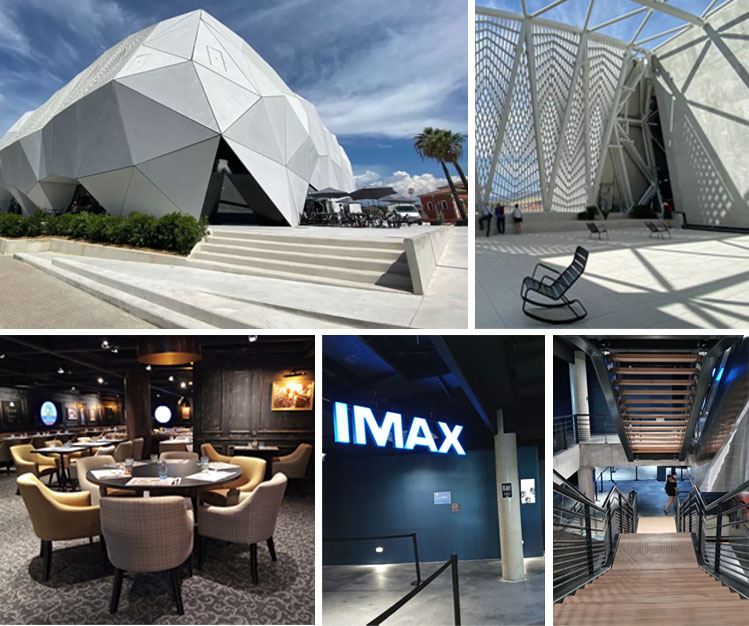 |
An
initiative of the EU MEDIA Programme with the support of the Italian
Government Since 1992 MEDIA Salles has been promoting the European cinema and its circulation at theatrical level |
|
|
Cineum, Cannes The Cineum aims to amaze... In this very special year, with the Festival daring to offer a dual approach - a live red carpet and the market section partly online and partly live - Cannes is not only talking films but cinemas, too. It began with Pierre Lescure, President of La Croisette’s Festival, announcing that the competition would be able to count on Europe's two finest screens, at the Cineum, the brand-new complex located in Cannes la Bocca. Some might object to the title but undoubtedly the Cineum is a very special building, which defies and upturns the clichés according to which all multiplexes tend to look the same. The fruit of an investment of 33 million euros, this building, conceived six years earlier, is the first step in a wide-reaching project promoted by the Cannes Municipality, called “Cannes on Air” which is to include a university centre focusing on writing and a sturtup incubator for the audiovisual sector. In the meantime, the short-term objective is to make the town that hosts the oldest festival in the world, second only to the Venice Festival, a pole of attraction to spectators in the area. With the Cineum, which boasts 12 auditoriums for a total of 2,450 seats, the present offer can be more than doubled: until the beginning of this month, Cannes was served by two cinemas, for a total of 12 screens, located in the centre, two steps away from the famous Palais. The design of the Cineum is the work of the architect Rudy Ricciotti, to whom we also owe the MuCem in Marseilles and the bridge Pont de la République in Montpellier. Built from fibre-reinforced concrete, it is shaped like a polyhedron with numerous irregular faces. Opal-white in colour, they create a well structured mass that evokes a giant iceberg washed up on the Mediterranean coast. The different angles make it possible to mirror the many variations in the light of the South of France. The only interruptions in its compact structure are made to accommodate the glass doors on the ground-floor, whilst looking towards the little Mandelieu airport and, further away, towards the centre of Cannes, a vast terrace suddenly appears, hollowed out of the mass and veiled by an openwork metal structure evoking Arabic architecture. A spectacular bar, worked on by the artist and designer Arik Levy, looks out into this open-air space, which is rather unusual in a cinema. Inside, the building is cavelike, vast and shady, conceived as a neutral background suited to hosting exhibitions and destined to emphasise the link between the cinema and other arts. The heart of this space, which leads out onto the entrances to the auditoriums and the refreshment and restaurant areas, is occupied by a fine staircase in wood and metal. No colourful carpeting but a concrete floor creating a continuum with the soberly painted walls, mostly in dark and earthy tones. The twelve auditoriums are located on three floors and each one represents a variation on a shared theme, based on neon-tube lighting placed horizontally halfway down the walls and on the square-shaped velvet armchair seats, some of which be reclined or are fitted with individual speakers. A particularly high investment has been made in the technology, which includes laser projectors and the Dolby Atmos sound system. The most striking theatre is the one fitted with Imax technology: it enthrones an almost 23-metre-wide screen, produced by the Canadian company Strong, facing 513 motorised armchair seats. For now, this “wonder” has been reserved for festival-goers but by the end of the month, the CCC - the Compagnie Cinématographique de Cannes - envisages opening it to the public. In accordance, of course, with the rules for accessing cinemas foreseen by the French Government: as from 21 July, the health “pass” must be shown, attesting to two administrations of Covid vaccine or a negative swab carried out in the previous 48 hours. This is an obligation that has sparked off a reaction from the exhibitors’ association: why should this measure be applied so soon in cinemas, when for other sectors, such as restaurants, it does not come into force until August? Summing up, the Cineum starts life on an uphill path ...
|
